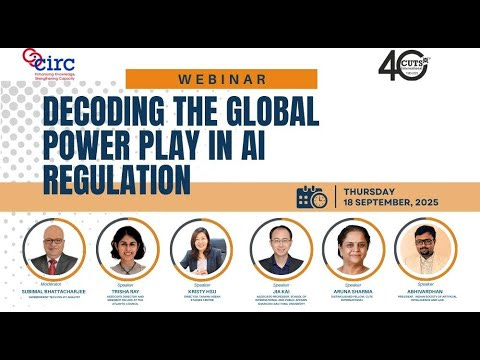The video by The Bharat Pacific explains the features of the Version 2.0 of the AIACT.IN draft developed by Indic Pacific Legal Research.
The Artificial Intelligence (Development & Regulation) Bill, 2023 (AIACT.In) Version 2, released on March 14, 2024, builds upon the framework established in Version 1 while introducing several new provisions and amendments. This draft legislation proposed by our Founder, Mr Abhivardhan, aims to promote responsible AI development and deployment in India through a comprehensive regulatory framework.
Please note that draft AIACT.IN (Version 2) is an Open Proposal developed by Mr Abhivardhan and Indic Pacific Legal Research, and is not a draft legislation proposed by any Ministry of the Government of India.
You can access and download the Version 2 of the AIACT.IN by clicking below.
Key Features of AIACT.In Version 2
Categorization of AI Systems: Version 2 introduces a detailed categorization of AI systems based on conceptual, technical, commercial, and risk-centric methods of classification. This stratification helps in identifying and regulating AI technologies according to their inherent purpose, technical features, and potential risks.
Prohibition of Unintended Risk AI Systems: The development, deployment, and use of unintended risk AI systems, as classified under Section 3, is prohibited in Version 2. This provision aims to mitigate the potential harm caused by AI systems that may emerge from complex interactions and pose unforeseen risks.
Sector-Specific Standards for High-Risk AI: Version 2 mandates the development of sector-specific standards for high-risk AI systems in strategic sectors. These standards will address issues such as safety, security, reliability, transparency, accountability, and ethical considerations.
Certification and Ethics Code: The IDRC (IndiaAI Development & Regulation Council) is tasked with establishing a voluntary certification scheme for AI systems based on their industry use cases and risk levels. Additionally, an Ethics Code for narrow and medium-risk AI systems is introduced to promote responsible AI development and utilization.
Knowledge Management and Decision-Making: Version 2 emphasizes the importance of knowledge management and decision-making processes for high-risk AI systems. The IDRC is required to develop comprehensive model standards in these areas, and entities engaged in the development or deployment of high-risk AI systems must comply with these standards.
Intellectual Property Protections: Version 2 recognizes the need for a combination of existing intellectual property rights and new IP concepts tailored to address the spatial aspects of AI systems. The IDRC is tasked with establishing consultative mechanisms for the identification, protection, and enforcement of intellectual property rights related to AI.
Comparison with AIACT.In Version 1
Expanded Scope: Version 2 expands upon the regulatory framework established in Version 1, introducing new provisions and amendments to address the evolving landscape of AI development and deployment.
Detailed Categorization: While Version 1 provided a basic categorization of AI systems, Version 2 introduces a more comprehensive and nuanced approach to classification based on conceptual, technical, commercial, and risk-centric methods.
Sector-Specific Standards: Version 2 places a greater emphasis on the development of sector-specific standards for high-risk AI systems in strategic sectors, compared to the more general approach taken in Version 1.
Knowledge Management and Decision-Making: The importance of knowledge management and decision-making processes for high-risk AI systems is highlighted in Version 2, with the IDRC tasked with developing comprehensive model standards in these areas. This aspect was not as prominently featured in Version 1.
Intellectual Property Protections: Version 2 recognizes the need for a combination of existing intellectual property rights and new IP concepts tailored to AI systems, whereas Version 1 did not delve into the specifics of intellectual property protections for AI.
Detailed Description of the Features of AIACT.IN Version 2
Significance of Key Section 2 Definitions
Section 2 of AIACT.IN provides essential definitions that signify the legislative intent of the Act. Some of the key definitions are:
Artificial Intelligence: The Act defines AI as an information system that employs computational, statistical, or machine-learning techniques to generate outputs based on given inputs. This broad definition encompasses various subcategories of technical, commercial, and sectoral nature, as set forth in Section 3.
AI-Generated Content: This refers to content, physical or digital, that has been created or significantly modified by an artificial intelligence technology. This includes text, images, audio, and video created through various techniques, subject to the test case or use case of the AI application.
Algorithmic Bias: The Act defines algorithmic bias as inherent technical limitations within an AI product, service, or system that lead to systematic and repeatable errors in processing, analysis, or output generation, resulting in outcomes that deviate from objective, fair, or intended results. This includes technical limitations that emerge from the design, development, and operational stages of AI.
Combinations of Intellectual Property Protections: This refers to the integrated application of various intellectual property rights, such as copyrights, patents, trademarks, trade secrets, and design rights, to safeguard the unique features and components of AI systems.
Content Provenance: The Act defines content provenance as the identification, tracking, and watermarking of AI-generated content using a set of techniques to establish its origin, authenticity, and history. This includes the source data, models, and algorithms used to generate the content, as well as the individuals or entities involved in its creation, modification, and distribution.
Data: The Act defines data as a representation of information, facts, concepts, opinions, or instructions in a manner suitable for communication, interpretation, or processing by human beings or by automated or augmented means.
Data Fiduciary: A data fiduciary is any person who alone or in conjunction with other persons determines the purpose and means of processing personal data.
Data Portability: Data portability refers to the ability of a data principal to request and receive their personal data processed by a data fiduciary in a structured, commonly used, and machine-readable format, and to transmit that data to another data fiduciary.
Data Principal: The data principal is the individual to whom the personal data relates. In the case of a child or a person with a disability, this includes the parents, lawful guardian, or lawful guardian acting on their behalf.
Data Protection Officer: A data protection officer is an individual appointed by the Significant Data Fiduciary under the Digital Personal Data Protection Act, 2023.
Digital Office: A digital office is an office that adopts an online mechanism wherein the proceedings, from receipt of intimation or complaint or reference or directions or appeal, as the case may be, to the disposal thereof, are conducted in online or digital mode.
Digital Personal Data: Digital personal data refers to personal data in digital form.
Digital Public Infrastructure (DPI): DPI refers to the underlying digital platforms, networks, and services that enable the delivery of essential digital services to the public, including digital identity systems, digital payment systems, data exchange platforms, digital registries and databases, and open application programming interfaces (APIs) and standards.
Knowledge Asset: A knowledge asset includes intellectual property rights, documented knowledge, tacit knowledge and expertise, organizational processes, customer-related knowledge, knowledge derived from data analysis, and collaborative knowledge.
Knowledge Management: Knowledge management refers to the systematic processes and methods employed by organizations to capture, organize, share, and utilize knowledge assets related to the development, deployment, and regulation of AI systems.
IDRC: IDRC stands for IndiaAI Development & Regulation Council, a statutory and regulatory body established to oversee the development and regulation of AI systems across government bodies, ministries, and departments.
Inherent Purpose: The inherent purpose refers to the underlying technical objective for which an AI technology is designed, developed, and deployed, encompassing the specific tasks, functions, and capabilities that the AI technology is intended to perform or achieve.
Insurance Policy: Insurance policy refers to measures and requirements concerning insurance for research and development, production, and implementation of AI technologies.
Interoperability Considerations: Interoperability considerations are the technical, legal, and operational factors that enable AI systems to work together seamlessly, exchange information, and operate across different platforms and environments.
Open Source Software: Open source software is computer software that is distributed with its source code made available and licensed with the right to study, change, and distribute the software to anyone and for any purpose.
National Registry of Artificial Intelligence Use Cases: The National Registry of Artificial Intelligence Use Cases is a national-level digitized registry of use cases of AI technologies based on their technical & commercial features and inherent purpose, maintained by the Central Government for the purposes of standardization and certification of use cases of AI technologies.
These definitions provide a clear understanding of the scope and intent of AIACT.IN, ensuring that the Act effectively addresses the complexities and challenges associated with the development and regulation of AI systems in India.
Here is a list of some FAQs (frequently asked questions, that are addressed in detail.
Is AIACT.IN Version 2.0 friendly towards promoting AI innovation?
How does the AIACT.IN Version 2 addresses deepfakes and untested AI models?
Explain how are AI technologies classified in AIACT.IN Version 2.
Does or can the AIACT.IN Version 2 legally support open source AI practices and systems? If yes, then how?
How does AIACT.IN Version 2 help technology professionals and firms? This is not even a government-proposed draft.
Here is how you can participate in the AIACT.IN discourse:
Read and understand the document: The first step to participating in the discourse is to read and understand the AIACT.IN Version 2 document. This will give you a clear idea of the proposed regulations and standards for AI development and regulation in India. To submit your suggestions to us, write to us at vligta@indicpacific.com.
Identify key areas of interest: Once you have read the document, identify the key areas that are of interest to you or your organization. This could include sections on intellectual property protections, shared sector-neutral standards, content provenance, employment and insurance, or alternative dispute resolution.
Provide constructive feedback: Share your feedback on the proposed regulations and standards, highlighting any areas of concern or suggestions for improvement. Be sure to provide constructive feedback that is backed by evidence and data, where possible.
Engage in discussions: Participate in discussions with other stakeholders in the AI ecosystem, including industry experts, policymakers, and researchers. This will help you gain a broader perspective on the proposed regulations and standards, and identify areas of consensus and disagreement.
Stay informed: Keep up to date with the latest developments in the AI ecosystem, including new regulations, standards, and best practices. This will help you stay informed and engaged in the discourse, and ensure that your feedback is relevant and timely.
Collaborate with others: Consider collaborating with other stakeholders in the AI ecosystem to develop joint submissions or position papers on the proposed regulations and standards. This will help amplify your voice and increase your impact in the discourse.
Participate in consultations: Look out for opportunities to participate in consultations on the proposed regulations and standards. This will give you the opportunity to share your feedback directly with policymakers and regulators, and help shape the final regulations and standards. You can even participate in the committee sessions & meetings held by the Indian Society of Artificial Intelligence and Law. To participate, you may contact the Secretariat at executive@isail.co.in.









